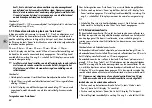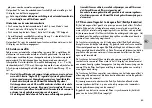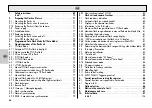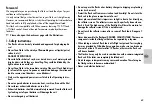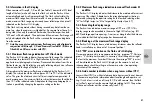
73
ķ
As soon as the above settings have been made you can start shooting flash
pictures when flash readiness is indicated (see 5.1).
4. Operating modes of the flash unit
4.1 TTL flash mode (Fig. 3)
The TTL flash mode is a very simple way to achieve excellent flash shots. In
this mode exposure readings are taken by a sensor built into the camera
which measures the light through the camera lens (TTL). The electronic control
circuit within the camera transmits a stop signal to the flash unit after expo-
sure by the correct amount of light, thereby instantly interrupting the flash.
The advantage of this flash mode is that all factors influencing correct ex-
posure (filters, change of aperture and focal length with zoom lenses, exten-
sions for close-ups, etc.) are automatically taken into account. You need not
worry about setting the flash, the camera’s electronic system automatically
determines the correct amount of flash light required. For the maximum flash
range please observe the distances given in the flash unit’s LC display
(see 5.4) and the information in section 5.5. If flash exposure was correct,
the flash unit’s LC display indicates “o.k.” for about 3 sec. (see 4.5).
The TTL flash mode is supported by all camera modes (e.g. Program “P”,
Aperture Priority Mode “A”, Shutter Priority Mode “S”, Vari or Scene Modes,
Manual Mode “M”, etc.).
For analog cameras, a film must be loaded in the camera to test the TTL
function. Please check whether limits regarding maximum film speed or
ISO value (e.g. maximum ISO 1000) are applicable to the given camera
when in TTL mode (refer to the camera’s operating instructions)!
Various digital SLR cameras do not support the normal TTL flash mode
of analog cameras. If the flash unit is used in conjunction with Group D
cameras (see Table 1), the D-TTL or D-TTL 3D flash mode must be select-
ed on the flash unit (see 4.2). When using the flash unit with Group E
cameras (see Table 1) you must set the i-TTL or i-TTL BL flash mode on
the flash unit (see 4.3).
☞
Setting procedure for TTL flash mode
• Mount the flash unit on the camera.
• Switch on the flash unit and the camera.
• Continue depressing the “Mode” key until “TTL” flashes on the LC display.
• The setting becomes immediately effective. The LC display returns to its nor-
mal state after approx. 5 sec.
Pronounced differences in contrast, e.g. a dark subject in snow, may
make it necessary to correct the exposure settings (see 4.4).
4.1.1 Automatic TTL fill-in flash in daylight (Fig. 5 and 6)
Most camera models automatically activate the fill-in flash mode when in
auto program mode “P”, Vari or a Scene mode in daylight (see the camera’s
operating instructions).
Fill-in flash overcomes troublesome dense shadows and produces a more
balanced exposure between subject and background with contre-jour shots.
The camera’s computer-controlled metering system sets the most suitable
combination of shutter speed, working aperture and flash output.
Ensure that the contre-jour light source does not shine directly into the
lens as this will mislead the camera’s TTL metering system!
In this instance there is no setting or display on the flash unit for automatic
TTL fill-in flash.
4.1.2 Matrix-controlled TTL fill-in flash
In this flash mode the subject and the background lighting are automatically
balanced without overexposing the subject. The camera establishes the ex-
posure setting for the ambient light by matrix metering.
Various Nikon cameras support the matrix-controlled TTL fill-in flash mode
(see operating instructions of the camera and Table 1).
Some cameras (F4 or F4s for example) do not support the matrix-con-
trolled TTL fill-in flash mode for SPOT exposure metering. This flash
mode will then either be automatically cancelled or cannot be acti-
vated, so that the normal TTL flash mode will be performed.
☞
☞
☞
Summary of Contents for MECABLITZ 54 AF-1 N
Page 45: ...45 ĸ ...
Page 67: ...67 ń ...
Page 89: ...89 ķ ...
Page 111: ...111 ƴ ...
Page 141: ...141 ...




